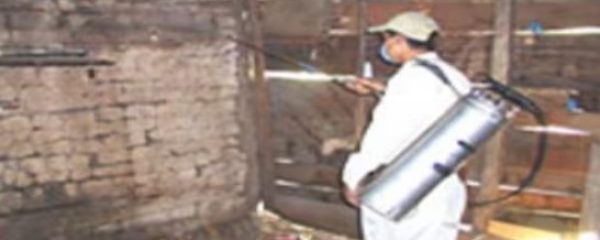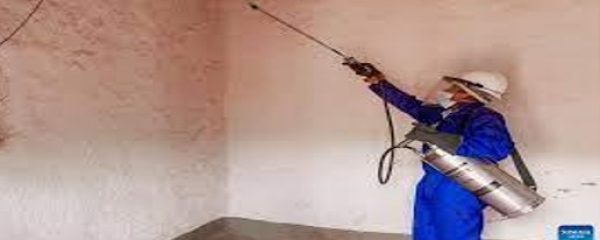VBD Program
VBD Program
Vector-Borne Diseases Eradication Programme
Preventive measure against MPox/Covid/Malaria/Dengue/Chikangunia/Lympha tic Filariasis/Kalajar/Japanese Encephalytis Infection
Sponsored By: New Development Bank(BRICS) and World Health Organisation (WHO)
BOQ FOR INFECTIOUS DISEASES ERADICATION PROGRAM
Preventive Strategy
Disinfection is process of eliminating infectious organisms by using chemical or physical agents. The antimicrobial agents designated as disinfectants are sometimes used alternatively as sterilizing agents, sanitizers or antiseptics. World Health Organization (WHO) and Government of India have adopted various sanitization and disinfection strategies to prevent the infection of microbial diseases.


Target area
- Indoor/Outdoor Residual Spraying in Selected High-Risk Areas;
- Spray and sanitize residential houses, public places and offices in both urban and rural areas under the Infectious Diseases Eradication Program under the guideline of World Health Organization (WHO).
Indoor Residual Spraying
- All Interior Walls and Ceilings
- Underside of furniture, cracks, crevices
- Backside of doors and windows
- Water residue in Air Coolers
- Sewerage storage in household
- Back drum of AC and Refrigerator
- Dark corners, shells, racks and dumping places
- Storehouses and Storage areas
Outdoor Spraying
- Public Utility Places like Latrines and Urinals
- Backside of Hospital, School, Anganwadi and Community Centre
- Drainage and Sewerage lines
- Water Dumping Areas
- Ponds, unused well, waterbodies
- Cowshed, animal shelter houses
- Garbage, dustbin, shrimp areas
- Small forest areas, weeds and greenfield
Spray Operation Strategy
- Spray operations are to be carried out in all areas. However, the priority of spray will be given to High-Risk areas all over the country
- While planning for spray, the epidemiological data of preceding three years are considered for selecting the population to be protected.
Spray Technical Details
The required quantity of insecticide should be issued to the squads each day by the supervisor after checking balance stocks available from previous day’s supplies. The preparation of the spray suspension is made just before the start of the spray operations every day. It is important that the suspension is made correctly so that the correct dosage is applied on the sprayed surfaces. The procedure for the preparation of the suspension is the same irrespective of the insecticide. However, the quantity of the insecticide used per 10 litres of water will depend on the insecticide used. The required quantity of the insecticide is measured with a plastic mug and poured into a 15-litre bucket. A paste is made with a small quantity of water. The remainder of water is then poured slowly into the bucket and the insecticide water mixture is stirred vigorously to obtain a uniform suspension. The suspension is then poured into another bucket through a cloth sieve to remove any particulate matter that might clog the nozzle of the spray pump. The spray lance should be kept 45 cms (18 inches) away from the wall surface. The swath should be parallel. Spray is applied in vertical swath of 53 cm (21 inches) wide. Successive swaths should overlap by 7.5 cm (3 inches). Spray is done from roof to floor, using downward motion, to complete one swath; then stepping sideways and spraying upwards from floor to roof. Do not let the spray drip to the floor. The discharge rate should be 740 to 850 ml per minute. To obtain the above discharge rate, the pump man should give 20 to 26 strokes per minute with 10-15 cms plunger movement at a pressure of 10 PSI (0.7 kg/sq.cm) at the nozzle tip. If the spray stops due to a blockage in the nozzle, the nozzle cap be unscrewed to remove the blockage and replaced with a new one. The blocked nozzle should be put in a container with water for a few hours before the blockage is removed with a finer wire. The supervisor through physical verification should verify the quality and coverage of spray randomly. It takes about 5 minutes to spray a house with an average surface area of 150 sq. metres. A daily summary of spray operations should be maintained by the field supervisor and verified by the health workers showing the areas covered, percentage room coverage and insecticide consumption.
Supervisors’ Work Module
- The Supervisor will be provided with the insecticide to be sprayed at the district level along with PPE kits, protective masks, gloves and shoes. The safe keep and proper usage will be the responsibility of the Supervisor.
- The supervisor will be properly trained and equipped to carry out the spray work. The service provider will ensure that the manpower employed by them follow the safety precautions during the handling, storage and use of the materials as conveyed to them and will be responsible for their own safety during the above-mentioned process.
- The Supervisor will strictly follow the IRS model system of Spraying Insecticides and Disinfection work in the Targeted Area of Intervention
Boq For Spray Programme
Community participation
- Involvement of Gram Panchayats in successful indoor/outdoor residual insecticide spray is an essential aspect of the Programme. Gram Panchayats/village/ local bodies/ village heads/ Block Development Officers/ Mahila Mandals/ Village Mukhiya are to be informed about the spray schedule at least before a week.
- The District Collector and District Health Officer must be informed in advance and their cooperation be requested to facilitate the actual spray inside of human dwelling with the objective of full coverage of targeted population.
Training and Operational Guidelines
- One-day training will be provided to each team on the do’s and don’ts about the IRS Spray Work. The training regimens include components on preparedness, operations, safety measures and evaluation.
- The spraying team will be trained to follow: (1) date-wise route chart; (2) record the number of rooms, houses sprayed, locked or refused in the register; (3) record attendance of the team members; (4) maintain stock register for entry of spray pumps, nozzles, and solution; and (5) maintain the daily diary.
- Proper training for maintenance of the records will be given before Spray program
Before And After Spray Programme
- Check the spray equipment for proper discharge rate; (2) solution preparation; (3) correct mixing; (4) spray technique; and (5) usage of proper safety equipment.
- The Supervisors will be also trained for post-spray activities i.e. (1) washing of spray equipment; (2) disposal of leftover solution; (3) coverage of rooms; and (4) observation of any side effects.
Supervision, Process And Performance Indicator
Supervision of spray operations is a very important activity to ensure that spray operations are carried out according to correct technical procedures, which is essential for taking corrective action, and achieve the programme goals. Supervision is carried at all levels of programme implementation.
Location, Manpower and Duration
- LOCATION: All States including High Diseases Burden States
- MANPOWER: 2-4 Supervisors for each Block/ULB as per area of coverage and population density
- DURATION: 06 Months, to be extended afterwards.
- TIMING OF WORK: 8 Hours daytime. Flexible area wise.
- All Supervisors must having good health conditions and shouldn’t have been suffering from cold, cough like symtoms.
- All Supervisors will be covered under Mediclaim Insurance by Service Provider.
- L1 Channel Partner shall provide 2 (Two) sets of Spray Machines, PPE Kits, Gloves, Masks, Shoes and other accessories
Pay-out and Billing
- Invoice for the work completed during the time duration will be raised by 1st week of the next month. Invoice will be verified and released by PIA within 15 Working days excluding Sundays and holidays subject to the conditions that the bill raised by the service provider is found in order along with the required supporting documents and materials.
- The Service Provider will have to submit all required documents, videos and datasheets corroborating the work done with the Invoice. After cross-check and proper verification, the Invoice will be cleared.
- Fraudulent and false invoices shall not be cleared and the authority reserves the right to take proper legal action against such activities
Pay-out
- 250/- per household (Average 1200 Sq.ft. area all inclusive)
- GST chargeable as per Govt norms
- All payments shall be done through Electronic Fund Transfer
Checklist for Verification
- Letter of Sarpanch/Mukhiya for Gram Panchayat and Ward Councilor for ULB in Official Letterhead with proper Rubber Stamp. The format of Letter will be provided with MoU.
- 5(Five) 30-second duration videos authenticating the spray work in different locations in each village/council.
- Excel Datasheet filled up manually by the Supervisor during Spray work with properly filled up data about the beneficiaries.
